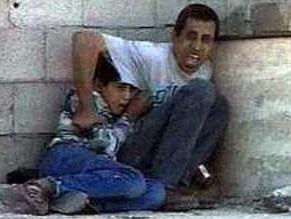|
World Jewish News

Philippe Karsenty, director of the Media Ratings -- a media watchdog group -- claims Charles Enderlin's France 2 tv report on the Dura incident was doctored
|
France’s highest appeals court to rule on al-Dura dispute with France 2 tv channel
28.02.2012, Israel and the World Controversy continues to stalk the memory of Mohammed al-Dura more than 11 years after the Palestinian boy was shot dead in an exchange of fire between Israeli troops and Palestinian fighters in Gaza.
On Tuesday, France's highest appeals court is to rule on a dispute between France 2, the channel whose iconic images of the incident were beamed around the world, and a French activist who claims the footage was staged.
The death of 12-year-old Dura, who died in the arms of his father, remains graven in the memories of most. The scene was captured on video by a France 2 cameraman, and quickly broadcast worldwide.
More than a decade later, with the intifada over, the report on Dura's death remains a major battlefield in the media war between Israel and the Palestinians.
In the Arab world, Dura quickly became a symbol with which to condemn the Israeli occupation. The image of the child keeled over was reproduced on posters, stamps and T-shirts. Streets were named in his memory.
On the other side, defenders of Israel contested the reporting of Charles Enderlin, France 2's Jerusalem correspondent, whose voice-over of the images in the report said Israeli bullets had killed the boy.
Some cast doubt of the provenance of those bullets, saying they were in fact Palestinian. But others claim the entire event was staged, that Dura did not in fact die in his father's arms.
"The issue could have quickly disappeared after the initial emotion stoked by the incredible violence of these images of a child in the process of dying," says Jerome Bourdon, a communications professor at Tel Aviv University.
"But these images became such a symbol -- for pro-Palestinians and pro-Israelis -- that no one could let go."
A key figure in the debate in France is Philippe Karsenty, director of the Media Ratings -- a media watchdog group -- who claims Enderlin's report on the Dura incident was doctored.
"Karsenty has expended tremendous energy to bring attention back to the matter. He seized the Dura affair with the idea that he would be the new (Emile) Zola of the (Alfred) Dreyfus affair," said Bourdon, author of "The Impossible Narrative: The Israeli-Palestinian Conflict and the Media."
Israeli authorities adopted the narrative of a staged incident late in 2007, after a period of relative silence on the issue.
Just two weeks ago, Prime Minister Benjamin Netanyahu congratulated French-Israeli doctor Yehuda David, after he was acquitted of defamation charges levelled by Dura's father Jamal.
David in 2008 wrote that scars on Jamal al-Dura, reportedly from injuries sustained during the shooting that killed his son, were in fact from previous injuries, supporting the theory that the incident had been staged.
In France, large parts of the Jewish community now subscribe to Karsenty's theory.
"It's not just a question of politicisation by extremists. Numerous French Jews felt during the second intifada that Israel was unjustly accused by the media," said Bourdon.
"They were shocked by the Dura affair. Karsenty's theory could not have had the same impact without this emotional dimension."
On the Palestinian side too, the images of Dura's death remain a potent symbol, according to Amal Jamal, a professor of political science at Tel AvivUniversity.
"These images contain all the history of the second intifada, the Palestinian tragedy, the inhumane conditions in which they live and the everyday nature of the force deployed against them by Israel," he said.
"It's of little importance whether the bullets that killed Mohammed were Palestinian or Israeli," he noted.
EJP
|
|
